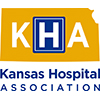 (June 2, 2023) – This week, the Kansas Hospital Association Board of Directors conducted its annual retreat and board meeting. They were joined by the Kansas Health Service Corporation Board of Directors. This meeting provided Kansas hospital leaders an opportunity to connect and reflect on the priorities of the association, as well as to set the direction as we move forward.
(June 2, 2023) – This week, the Kansas Hospital Association Board of Directors conducted its annual retreat and board meeting. They were joined by the Kansas Health Service Corporation Board of Directors. This meeting provided Kansas hospital leaders an opportunity to connect and reflect on the priorities of the association, as well as to set the direction as we move forward.
Of the variety of topics we addressed, the boards specifically leaned into the topic of workforce to evaluate the current landscape, what we have accomplished thus far, and the priorities going forward. The boards provided direction on several initiatives.
In the data realm, our annual vacancy and turnover survey saw the highest level of participation in over a decade, with 109 KHA member hospitals participating. We reviewed the new Health Care Vacancies and Turnover 2023 Report. Additionally, the results of KHA and Gallagher's compensation and benefits survey are now available, and soon to come will be the results of the physician compensation survey that Gallagher rolled out for the first time this year. We know decisions are driven by data, and KHA is pleased to be able to provide these resources to better assist our members in workforce improvement efforts.
The boards discussed the health care apprenticeship opportunities for Kansas hospitals. A rural health care apprenticeship grant was awarded to Labette Health and Pratt Regional Medical Center, the Kansas State Board of Nursing approved a statement of support for LPN apprenticeships, the legislature passed the Kansas Apprenticeship Act that provides $7.5 million in tax credits for for-profit employers and $2.5 million in grants for not-for-profit employers wanting to pursue an apprenticeship program, and an intermediary company has been engaged to help hospitals with support in developing and administering registered apprenticeship programs.
KHA staff also were pleased to report that more than 100 school districts and over 2,000 students participated in the first annual Virtual Health Care Career Day. KHA hosted the event in collaboration with the Kansas Chamber of Commerce and Kansas State Department of Education to promote the wide variety of career possibilities in hospitals. The boards recommended improvements to the Virtual Health Care Career Day, but strongly encouraged KHA to continue its support of the program in the coming year. Another initiative discussed revolved around the HOSA chapter sponsorship opportunities. KHA continues to advertise the availability of the four remaining new chapter sponsorship opportunities through Healthworks to attract the next generation of health care professionals.
The boards learned of KHA's work with several health care networks in Kansas to bring together hospital leaders and higher education institutions to discuss ways to collaborate and jointly address workforce issues through workforce executive roundtables. Last September, the first of these meetings was conducted in Kansas City and one followed in February in Garden City with the Pioneer Health Network. Two more are planned for this summer and fall.
On the legislative front, the boards discussed multiple wins on workforce policies in the statehouse. In addition to the $2.5 million approved for health care organizations to pursue establishing apprenticeship programs, there were several other victories we achieved. This year, the Kansas Legislature passed the health care worker protection legislation that increases the penalties of assault and battery. The legislature also approved the Kansas Adult Learner Grant Act, which provides scholarships to adults who return to school to pursue a degree or credential, as well as a tax credit to incentivize those adults to remain living and working in Kansas after graduation.
Kansas entered into the Counseling Compact to facilitate the interstate practice of licensed professional counselors. Additionally, Kansas expanded rural housing incentive districts to urban areas to encourage the construction of new homes across the state, which is essential to provide places to live for our health care workers.
While these are great steps, we recognize there is still much to be done. The boards expressed future interest in the areas below:
- Prioritizing initiatives to streamline efforts for those transitioning from military to civilian life (military TAP program) to work in health care
- Reaching non-traditional members of the workforce (including those with whom English is a second language and individuals in Project SEARCH)
- Creating an allied health professions loan repayment program
- Expanding clinical sites (credentialing and matching)
- Showcasing a health care career aptitude test to even younger students, ensuring strong high school classes and pathways into health care careers, among a wide variety of other workforce priorities
--Chad Austin